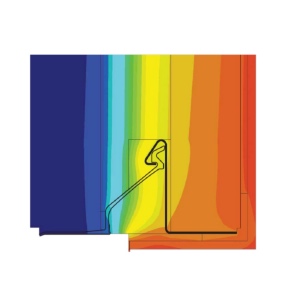
Understanding thermal bridging
With a drive towards more energy efficient homes, thermal bridging is becoming more important within the industry. But what is thermal bridging?
A thermal bridge is part of the building envelope through which heat is transferred at a substantially higher rate than through the surrounding area. The heat loss at these junctions are considered independently of the U-Values of the elements.
It has been found that up to 30% of all heat loss from buildings is due to thermal bridging. Therefore, building regulations now require the heat loss through U-Values and Thermal Bridging (Psi values) to be accounted via SAP calculations.
The two main types of thermal bridges in building are repeating and non-repeating. Repeating thermal bridges occur regularly within a typical dwelling; for example where timber studs bridge a layer of insulation in a cavity wall. These are taken into account in the ‘U-Value’ calculation.
Non-repeating thermal bridges occur at junctions between building elements and around openings, these are measured as Psi values (linear thermal heat transmittance). The Psi values are accounted for in the SAP calculation.
Non-repeat thermal bridging is measured as a Psi Value, which is a measure of linear thermal heat transmittance usually at a junction in a dwelling. A Psi value is calculated using specialist thermal modelling software, where the thermal modeller will draw the construction detail in the software package and add in the material conductivities. This sophisticated software then calculates the heat loss at the junction, subsequently producing a Psi value.
Psi values are based on standard construction details but default Psi values can be enhanced through the use of thermal modelling by a third party-accredited assessor. Improved Psi values can help eliminate the need for costly eco add-ons, such as solar panels, and are worth exploring as a means to reduce the cost of a new build whilst meeting fabric requirements, energy requirements of Part L of the building regulations and Code of sustainable homes.
Visit the Keystone Lintels website
Download the Keystone Lintels Product Guide
Download the Hi-therm+ brochure
Download the Keyslip Brick Feature Lintels brochure
Visit Supplier's page
Latest news

22nd November 2024
Insight Data: Using Marketing Data to Build a Successful Business in 2025
Alex Tremlett, Insight Data’s Commercial Director, discusses the challenges for construction firms in 2025 and shares six strategies for success…
Posted in Articles, Building Industry News, Building Services, Information Technology, news, Research & Materials Testing
22nd November 2024
Purplex: A tough Budget, but opportunity still knocks
Incoming governments, especially those with significant mandates, inevitably come into power on a tidal wave of optimism coupled with hope that ‘Things can only get better’. Andrew Scott, MD of construction-focused, full-service agency Purplex, talks…
Posted in Articles, Building Industry News, Building Services, Information Technology, news, Posts, Research & Materials Testing
22nd November 2024
Pop Up Power Supplies Gets Arty in Yorkshire
Pop Up Power Supplies has installed 13 new electricity units at The Hepworth Wakefield – read more in this article…
Posted in Articles, Building Industry News, Building Products & Structures, Building Services, Case Studies, Civil Engineering, Facility Management & Building Services, Garden, Hard Landscaping & Walkways, Landscaping, Posts, Restoration & Refurbishment, Retrofit & Renovation
22nd November 2024
OPT Services Revolutionises Fibre Cable Capping with Eco-Friendly Innovation
UK-based OPT Services has unveiled SlimLine™ Capping, a groundbreaking fibre cable protection solution that promises to deliver significant environmental and installation advantages to the fibre optic industry.
Posted in Articles, Building Industry News, Building Products & Structures, Building Services, Facility Management & Building Services, Information Technology, Innovations & New Products, Sustainability & Energy Efficiency
 Sign up:
Sign up: